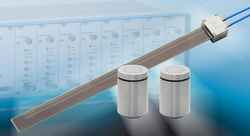
Posted to News on 13th Apr 2012, 09:46
Capacitive sensors measure gaps in hard-to-access areas
Micro-Epsilon is launching the capaNCDT CSG high-accuracy, non-contact capacitive displacement sensor for measuring gap widths in difficult-to-access areas or objects. The probe can be manipulated and bent around obstacles in order to measure gap widths.

With the new capaNCDT CSG sensor, electrodes are applied to the top front and back of a 20cm-long printed circuit board substrate. Using the sensor electrodes and the differential calculation method, the width of a gap can be determined very accurately while moving the sensor into the gap.
The capaNCDT CSG has a special flexible probe that enables the sensor to be used in applications where the measurement target or object is difficult to access. The sensor is capable of measuring gap widths of 0.9mm up to 4.9mm at a resolution of up to 90nm. However, the sensor requires a metal measurement target and a relatively clean measurement gap.
Longer range
In addition to its new CSG sensor, Micro-Epsilon has developed a similar sensor that offers longer measurement ranges. The new capaNCDT CSE sensor has the same dimensions as the CSG but provides up to 2.5 times larger measuring ranges. This is achieved by equipping the sensor with a shielded electrode that is set back from the probe, which means that for a similar measuring range, the CSE sensor dimensions are significantly smaller.
For the same measuring range, the capaNCDT CSE sensor therefore provides further benefits to the customer. The cylindrical design of the CSE sensor and a connector on the back of the unit offer users high versatility in terms of potential applications. The sensors can also be connected to any other Micro-Epsilon controller or electronics, which means sensor interchangeability is guaranteed.
Chris Jones, the Managing Director of Micro-Epsilon UK, comments: "Measuring gap width or the distance from one object to another at a certain depth are very common requirements in many industries. Conventional measuring methods are often unsuitable here, as they only record the gap at the surface and not at depth. The new capaNCDT CSG and CSE sensors are specifically designed to measure gap widths at depth in difficult-to-access areas using a flexible probe and compact, slimline sensor design."
Multi-channel, sub-nanometre measurements
For applications that require sub-nanometre resolution and multi-channel measurements, the CSG and CSE sensors can be used in conjunction with Micro-Epsilon's non-contact, capacitive measurement system, the capaNCDT 6500. This system offers sub-nanometre resolution, excellent temperature stability and rapid changeover of sensors without any recalibration required.
Micro-Epsilon's capaNCDT 6500 Series is available as a benchtop or 19-inch rack-mounted unit. Modular in design, the system can accept up to eight measuring channels to suit individual customer requirements. Due to its extreme resolution and flexibility, the system is suitable for high-accuracy R&D applications, test laboratories, quality assurance, academic institutions and also semiconductor manufacturing, military, aerospace and defence applications.
The capaNCDT 6500 uses an active-driven, hermetically sealed, triaxial RF cable, in combination with an active guarded three-electrode sensor. The system is therefore electron leakage-proof, creating a protected and homogeneous measurement field. This means users obtain stable, precise, interference-free measurement data.
The capacitive principle explained
With the capacitive principle, the sensor and target operate like an ideal parallel-plate capacitor; the two plate electrodes are formed by the sensor and the opposing target. If an AC current with constant frequency flows through the sensor capacitor, the amplitude of the AC voltage on the sensor is proportional to the distance between the capacitor electrodes. An adjustable compensating voltage is simultaneously generated in the amplifier electronics. After demodulation of both AC voltages, the difference is amplified and output as an analogue signal.
Because the sensor is constructed like a guard ring capacitor, almost ideal linearity and resolution against metal targets is achieved. The technology also offers high temperature stability, as changes in the conductivity of the target have no effect on the measurement. Capacitive sensors can also measure insulators.
The technology is sensitive to changes in the dielectric sensor gap and so operates most effectively in clean, dry applications. Cable length is also relatively short due to the effect of cable capacitance on the oscillating circuit tuning.
Follow the link for more information about Micro-Epsilon's capaNCDT CSG and CSE sensors.
No. 1 Shorelines Building
Shore Road
CH41 1AU
UNITED KINGDOM
+44 (0)151 355 6070






























